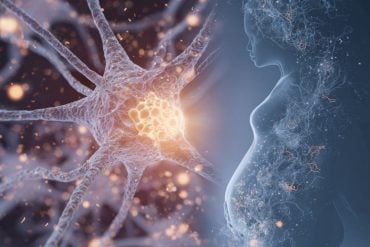Summary: Researchers have identified two forms of estrogen, estradiol and estriol, that may reduce inflammation and protect nerve fibers in progressive multiple sclerosis (MS). Using a virus model of the disease, the study found that both hormones lowered spinal cord inflammation, while estradiol significantly preserved the myelin sheath that protects nerve cells.
This protective effect mirrors the remission seen in many pregnant women with MS, when estrogen levels peak naturally. The findings open new possibilities for hormone-based therapies to slow or alleviate the most debilitating form of MS.
Key Facts:
- Hormonal Protection: Elevated estrogen levels, like those during pregnancy, appear to shield nerve fibers from damage in progressive MS.
- Estradiol Advantage: Both estradiol and estriol reduced inflammation, but estradiol provided stronger protection for the myelin sheath.
- Therapeutic Potential: These findings suggest estrogen-based therapies could complement existing MS treatments for patients with progressive disease.
Source: Texas A&M
About 100,000 of the estimated million people in the United States with multiple sclerosis (MS) have a progressive form of the disease, with symptoms that worsen continuously or after periods of remission.
“Progressive MS is profoundly challenging because it is relentless and treatment options are limited,” said Francisco P. Gomez, a neurologist who specializes in MS and neuroimmunology.
MS is believed to occur when the immune system attacks the myelin sheath — the protective coating of the nerve fibers that transmit electrical impulses throughout the body — and disrupt this communication. The disease occurs more often in women, older people and those in northern latitudes.

Symptoms include fatigue, numbness or tingling, bladder and bowel problems and cognitive issues, but difficulty walking and balancing are the most common symptoms — and these are more pronounced in the progressive form of the disease. In addition, the progressive form is more prevalent among Black patients.
Now, Gomez and colleagues with the Texas A&M University Health Science Center (Texas A&M Health) have identified two estrogens that show promise in reducing the symptoms of progressive MS: estradiol and estriol.
For their study, published in the Journal of Neuroimmunology, the team evaluated estriol and estradiol as possible treatment protocols through a study that used a virus to mimic progressive MS.
“Testing potential therapies by using virus models of the disease is important because we recently learned that the Epstein-Barr virus contributes to the formation and development of MS by triggering an autoimmune response in susceptible individuals,” said study author Jane Welsh, a neuroimmunologist with the Texas A&M College of Veterinary Medicine and Biomedical Sciences (VMBS) and the Texas A&M Naresh K. Vashist College of Medicine.
She added that while women are more likely than men to develop MS, once they have the disease and become pregnant, they tend to go into remission.
“That’s because during pregnancy — and especially in the third trimester — estradiol and estriol levels are elevated,” said study author Candice Brinkmeyer-Langford, a neurogenerative disease expert with the Texas A&M School of Public Health.
“Even women with MS who are on oral contraceptives experience fewer symptoms and have fewer relapses, so we evaluated how these hormones affect the myelin sheath.”
Estrogen is a group of hormones that primarily affect sex drive and reproductive development, especially for women.
Estradiol is more potent than estriol and is used for hormone replacement therapy in postmenopausal women. Estriol, on the other hand, is used off-label for a variety of conditions and is FDA-approved only for treating urinary incontinence in dogs.
The researchers found that both types of estrogen decreased inflammation in the spinal cord, but only estradiol significantly decreased the damage to the myelin sheath, and believe this could aid in the development of therapeutic interventions for people with progressive MS.
Gomez, a graduate of the Vashisht College of Medicine, was with VMBS during the study period and is currently with the University of South Dakota Sanford School of Medicine. Others involved with the research were Colin R. Young, with VMBS; Farida Sohrabji, the Joseph Shelton Professor of Neuroscience at the Vashisht College of Medicine; and Shameena Bake, with the Vashisht College of Medicine. Welsh, Brinkmeyer-Langford and Sohrabji also are with the Texas A&M Institute for Neuroscience.
Key Questions Answered:
A: Women with MS often experience remission during pregnancy, suggesting that high estrogen levels might help protect the brain and spinal cord.
A: Both estriol and estradiol reduced inflammation, but estradiol more effectively prevented myelin damage, a key factor in MS progression.
A: By showing that certain estrogens can protect nerve fibers, this study paves the way for hormone-based therapies targeting progressive MS symptoms.
About this multiple sclerosis research news
Author: Darren Benson
Source: Texas A&M
Contact: Darren Benson – Texas A&M
Image: The image is credited to Neuroscience News
Original Research: Open access.
“Therapeutic effects of estrogens on inflammatory demyelination in a mouse model of multiple sclerosis” by Francisco P. Gomez et al. Journal of Neuroimmunology
Abstract
Therapeutic effects of estrogens on inflammatory demyelination in a mouse model of multiple sclerosis
Multiple Sclerosis (MS) is a neurodegenerative autoimmune disease in which the immune system targets the myelin sheath of nerve axons, leading to a variety of neurological signs. Sex hormones are thought to be important factors in MS since pregnancy and oral contraceptives reduce both symptoms and relapses.
During pregnancy, remissions occur primarily in the third trimester when estradiol and estriol are elevated. We have investigated the role of these two hormones in an experimental model of virus-induced MS.
Theiler’s murine encephalomyelitis virus (TMEV) causes an inflammatory demyelinating disease in mice that resembles chronic progressive MS. To investigate the efficacy of estrogen therapy in the TMEV model, we used 6 experimental groups of 5-week-old female SJL/J mice.
Mice were either infected with TMEV or were sham infected with PBS. At 15 weeks pi, during the chronic inflammatory disease, all mice were ovariectomized and implanted with slow-release pellets of either 1) vehicle 2) estradiol or 3) estriol.
Weekly evaluation of clinical signs of disease revealed that estradiol treatment was associated with better clinical scores throughout the disease, and both treatment groups had significantly better scores than placebo (vehicle).
At termination (24 weeks) we examined the percent demyelination and inflammation in spinal cords, and measured serum levels of TMEV antibodies, for all mice.
Estradiol and estriol significantly decreased inflammation in the spinal cord, but only estradiol significantly decreased demyelination.
Virus infection and hormone treatment each significantly affected levels of TMEV antibodies. Antibody levels also differed significantly between estradiol and placebo groups, and between estriol and placebo groups, for all mice regardless of infection status.
These results suggest that estrogens may be effective therapies for progressive multiple sclerosis induced by viral infections.






